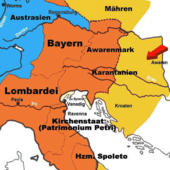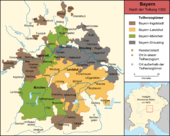Duchy of Bavaria
This article needs additional citations for verification. (August 2014) |
Duchy of Bavaria Herzogtum Bayern ( Latin ) | ||
|---|---|---|
| c. 555–1805 | ||
Feudal monarchy | ||
| Duke | ||
• 555–591 | Garibald I (first) | |
• 1597–1623 | Maximilian I (last) | |
| Historical era | Reunification | 1503 |
• Raised to Electorate | 1623 | |
| 1805 | ||
| Today part of | ||
The Duchy of Bavaria (
During internal struggles of the ruling
Geography
The medieval Bavarian stem duchy covered present-day
Over the centuries, several further seceded territories in the territory of the former stem duchy, such as the
History
Older stem duchy
The origins of the older Bavarian duchy can be traced to the year 551/555. In his
Agilolfings
Until the end of the first duchy, all rulers descended from the family of the
On the eastern border, changes occurred with the departure of the West Germanic
During
Carolingians

With the rise of the
By establishing direct rule over Bavaria, the Franks provoked the neighbouring
In order to secure Bavaria's eastern borders, and resolve other political and administrative questions, Charlemagne came to Bavaria in person, during the autumn of the same year (788). In Regensburg, he held a council and regulated issues regarding the Bavarian frontier counties (marches),[4] thus preparing the basis for future actions in the east. In 790, the Avars tried to negotiate a peace settlement with the Franks, but no agreement was reached.[5]
Bavaria then became the main base for the Frankish campaign against the Avars, which was initiated in 791. A large Frankish army, personally led by
Frankish acquisition of new eastern regions, particularly those between the
Younger stem duchy

In his 817 Ordinatio Imperii, Charlemagne's son and successor Emperor Louis the Pious tried to maintain the unity of the Carolingian Empire: while imperial authority upon his death was to pass to his eldest son Lothair I, the younger brothers were to receive subordinate realms. From 825 Louis the German styled himself "King of Bavaria" in the territory that was to become the centre of his power. When the brothers divided the Empire by the 843 Treaty of Verdun, Bavaria became part of East Francia under King Louis the German, who upon his death bequested the Bavarian royal title to his eldest son Carloman in 876. Carloman's natural son Arnulf of Carinthia, raised in the former Carantanian lands, secured possession of the March of Carinthia upon his father's death in 880 and became King of East Francia in 887. Carinthia and Bavaria were the bases of his power, with Regensburg as the seat of his government.
Due mainly to the support of the Bavarians, Arnulf could take the field against Charles in 887 and secure his own election as German king in the following year. In 899 Bavaria passed to
During the reign of Louis the Child,
Luitpoldings and Ottonians

The Carolingian reign in East Francia ended in 911 when Arnulf's son, King
Nevertheless, the self-confidence of the Bavarian dukes was an ongoing matter of dispute in the newly established
In 952 Duke Henry I also received the Italian
House of Welf

The last Ottonian duke,
Only with the establishment of Welf rule as dukes from 1070 by Henry IV was there a re-emergence of the Bavarian dukes. This period is characterized by the Investiture Controversy between Emperor and Pope, which strengthened Welf rule through siding with the pope's position.
After
The
Henry the Lion founded numerous cities, including Munich in 1158. Through his strong position as ruler of the two duchies of Saxony and Bavaria, he came into conflict with Frederick I Barbarossa. With the banishment of Henry the Lion and the separation of the March of Styria from Bavaria—raised to the Duchy of Styria in 1180 under Margrave Ottokar IV—the younger tribal duchy came to an end.
Wittelsbachs

From 1180 to 1918, the
Since there was no preference for succession of the firstborn in the Wittelsbach dynasty, in contrast to many governments of this time, there was in 1255 a division of the land into Upper Bavaria with the Palatinate and the Nordgau (headquartered in Munich) and Lower Bavaria (with seats in Landshut and Burghausen). There is still today a distinction made between upper and lower Bavaria (cf. Regierungsbezirke) .

Despite renewed division after a short time of reunification, Bavaria gained new heights of power with


In the 14th and 15th centuries, upper and lower Bavaria were repeatedly subdivided. Four Duchies existed after the division of 1392: Bavaria-Straubing, Bavaria-Landshut, Bavaria-Ingolstadt and Bavaria-Munich. These dukes often waged war against each other. Duke Albrecht IV of Bavaria-Munich united Bavaria in 1503 through war and primogeniture. However, the originally Bavarian offices Kufstein, Kitzbühel and Rattenberg in Tirol were lost in 1504.
In spite of the decree of 1506, Albert's oldest son
The succeeding duke, Albert's son, William V, had received a Jesuit education and showed keen attachment to Jesuit tenets. He secured the Archbishopric of Cologne for his brother Ernest in 1583, and this dignity remained in the possession of the family for more than 200 years. In 1597 he abdicated in favour of his son Maximilian I.
Maximilian I found the duchy encumbered with debt and filled with disorder, but ten years of his vigorous rule effected a remarkable change. The finances and the judicial system were reorganised, a class of civil servants and a national militia founded, and several small districts were brought under the duke's authority. The result was a unity and order in the duchy which enabled Maximilian to play an important part in the Thirty Years' War; during the earlier years of which he was so successful as to acquire the Upper Palatinate and the electoral dignity which had been enjoyed since 1356 by the elder branch of the Wittelsbach family. The Electorate of Bavaria then consisted of most of the modern regions of Upper Bavaria, Lower Bavaria, and the Upper Palatinate.
See also
- List of rulers of Bavaria
References
- ^ Bowlus 1995, pp. 86.
- ^ Bowlus 1995, pp. 47, 80.
- ^ Pohl 2018, pp. 378–379.
- ^ Nelson 2019, pp. 14, 257.
- ^ Pohl 2018, pp. 379.
- ^ Schutz 2004, p. 61.
- ^ Bowlus 1995, pp. 74, 86.
- ^ Bowlus 1995, pp. 24, 45, 85, 101.
- ^ Chisholm, Hugh (1911). Henry "The Proud". Vol. 13. Cambridge University Press. p. 293.
- ^ Görich, Knut: Die Staufer. Herrscher und Reich. Munich 2006. p. 41.
- ISBN 978-1-136-77518-5.
- This article incorporates text from a publication now in the public domain: Chisholm, Hugh, ed. (1911). "Bavaria". Encyclopædia Britannica (11th ed.). Cambridge University Press.
Sources
- Bowlus, Charles R. (1995). Franks, Moravians, and Magyars: The Struggle for the Middle Danube, 788–907. Philadelphia: University of Pennsylvania Press. ISBN 9780812232769.
- Goldberg, Eric J. (2006). Struggle for Empire: Kingship and Conflict under Louis the German, 817-876. Ithaca, NY: Cornell University Press. ISBN 9780801438905.
- ISBN 9780520314207.)
{{cite book}}: CS1 maint: location missing publisher (link - Pertz, Georg Heinrich, ed. (1845). Einhardi Annales. Hanover.
- ISBN 9783222123344.
- ISBN 9781501729409.
- ISBN 9781317872399.
- ISBN 9004131493.
- Scholz, Bernhard Walter, ed. (1970). Carolingian Chronicles: Royal Frankish Annals and Nithard's Histories. University of Michigan Press. ISBN 0472061860.



